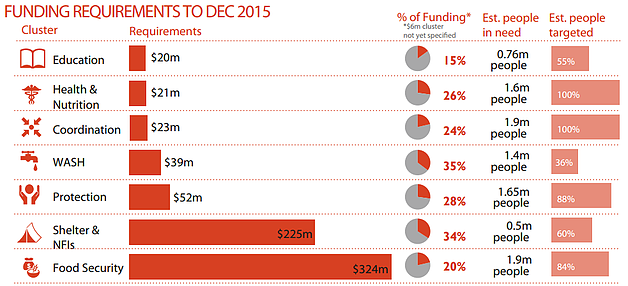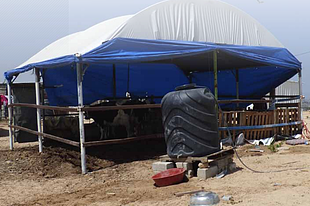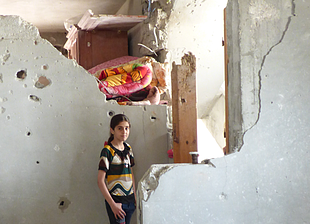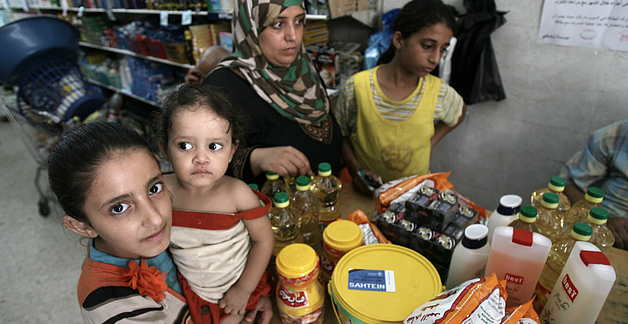Achievements and gaps in the implementation of the Strategic Response Plan (SRP) in the first quarter of 2015
What is the Strategic Response Plan (SRP)?
The SRP articulates the strategy of the humanitarian community to address the most urgent humanitarian and protection needs of the 1.6 million vulnerable Palestinians targeted for assistance. The SRP is produced by the Humanitarian Country Team. An annual plan has been launched for the oPt every year since 2003.
This is the first in a series of quarterly updates that will be produced to coincide with reporting milestones for the oPt SRP. For more information on the SRP please visit https://www.ochaopt.org/srp2015/
1.6 million vulnerable Palestinians targeted for assistance
So far in 2015, the humanitarian situation in the oPt remains fragile and needs have not diminished. In the West Bank, forced displacement and risk of forcible transfer remain a key concern, while in Gaza, although there was significant progress regarding repairs, not a single totally destroyed house has been reconstructed, and humanitarian agencies are the main actors implementing critical programming.
The current funding level of the 2015 SRP is encouraging and US$191 million (27 per cent) of the US$705 million requested had been received as of 10 April, according to the UN OCHA Financial Tracking System. This is despite the oPt requesting a much larger appeal in 2015 than in most previous years. In fact, 2015 was a record year in terms of global response plan requirements, with US$18.64 billion requested to respond to crises around the world. Only one third of SRP funding has been allocated to projects deemed top priority by the Humanitarian Country Team and clusters, and two thirds allotted for projects designated as ‘other’. Funding has tended to favour UN agencies and nearly 90 per cent (US$170 of the US$191 million) received so far has benefited four UN agencies. Most projects by NGO partners remain unfunded, many of them targeting specific vulnerable groups whose needs cannot otherwise be met.
Overall, humanitarian partners made good progress in the first quarter of 2015 towards their objectives in the 2015 SRP. However, a number of critical gaps remain:

Food Security: Further support needed for vulnerable agricultural and fishing livelihoods

- 1.9 million people in need
- 1.6 million people targeted
- US$324 million funding requirements
- US$64.7 million received (20%)
- 7 of 50 projects have received funding
- 4 of 26 appealing agencies have funding for their SRP projects
According to the Food Security Sector, 73 per cent of Palestinians in the Gaza Strip and 21 per cent in the West Bank are food insecure, necessitating continued interventions by food security partners. In the first quarter, most interventions focused on delivering food assistance to Palestinian families who lack economic access to food. However, unless further funds are received, the 1.3 million Palestinians in Gaza and 600,000 in the West Bank dependent on food aid will not receive further rounds of assistance after mid-2015.
The food security sector response plan also seeks to protect livelihoods and enhance the resilience of families dependent on farming, herding, breeding and fishing. However, only two of the 14 projects planned have received funding. Funding for these projects is essential to prevent further families from falling into dependency on food aid. These projects aim to provide inputs for agricultural production, diversify livelihood resources, rehabilitate productive assets and deliver emergency support such as seeds, fodder and irrigation equipment following shocks. In Gaza alone, an anticipated 48,000 people targeted by these livelihoods projects are not receiving support, putting families at risk of becoming dependent on food assistance.
Shelter and NFIs: temporary housing solutions needed in Gaza as reconstruction is yet to gain pace

- 0.5 million people in need
- 0.3 million people targeted
- US$225 million funding requirements
- US$77.3 million received (34%)
- 4 of 30 projects have received funding
- 2 of 17 appealing agencies have funding for their SRP projects
In sharp contrast to 2014, the Shelter and Non-Food Items (NFIs) Cluster has received adequate funding compared with other clusters/sectors, although the high cost of providing non-food items and constructing and repairing shelters needs to be taken into consideration.
In Gaza, the Shelter and NFIs cluster is providing emergency assistance to families to ensure people have access to basic services and minimum adequate shelter. The Cluster and the Ministry of Public Works and Housing have encouraged agencies responding to current shelter needs to prioritize the most vulnerable, providing emergency and temporary assistance only when specific needs have been identified and where permanent options are not available. NFIs were distributed in large quantities at the end of 2014 and the start of 2015, and partners were also able to restock supplies. In all, 138,000 kits were distributed in Gaza and 15,000 in the West Bank. Of the 17,500 families in need of temporary assistance, 14,400 have been supported with either cash for rent, temporary shelters which will last a number of years, caravans, or places in UNRWA collective centres. The 12,700 families who have received rental cash for four to six months will need further immediate shelter support once their subsidies run out.
With regard to permanent solutions, of the 144,200 housing units requiring repair, 73,500 units still require attention. Of the 12,600 houses that were totally destroyed, not one has yet been reconstructed. Constraints to reconstruction include limited access to construction materials as a result of delays in reaching agreement on the Residential Stream of the Gaza Reconstruction Mechanism (GRM) and lack of funding.
In the West Bank, displacement following demolitions in Area C and East Jerusalem is the main issue to which Shelter and NFIs Cluster partners are responding. Lack of funding has meant that 86 of the households affected since January 2015 are still awaiting a post-demolition response, although most received 24 -48 hour assistance with emergency items.
Furthermore, vulnerable families in 92 communities in Area C are considered to be living in housing in need of substantial upgrading and improvement, for which funds are currently lacking.
Water, Sanitation and Hygiene (WASH): carryover funding from 2014 has facilitated first quarter responses
- 1.4 million people in need
- 0.6 million people targeted
- US$39.2 million funding requirements
- US $13.9 million received (35%)
- 7 of 33 projects have received funding
- 2 of 17 appealing agencies have funding for their SRP projects
As a result of recent contributions, the WASH cluster has now received 35 per cent of its requested requirements. However, since this funding was only received in recent weeks, partners have had to utilise carryover funds where available to respond to needs in early 2015. UNICEF has made use of carryover funds in Gaza to increase access to water and sanitation services for 21,806 people, and to provide hygiene kits and vouchers for 5,458 people. The average Palestinian water consumption level remains at 50 litres per capita per day (lpcpd), well below the WHO standard of 100 lpcpd, and the need remains to increase access to safe water and sanitation throughout the oPt. Local resilience and preparedness of communities need to be enhanced through effective reduction of disaster risks.
Protection: funding shortfalls may halt some responses before the end of the year
- 1.65 million people in need
- 1.45 million people targeted
- US$51.9 million funding requirements
- US$14.4 million received (28%)
- 12 of 45 projects have received funding
- 6 of 31 appealing agencies have funding for their SRP projects
A number of protection partners are carrying out responses such as explosive remnants of war (ERW) risk assessment, clearance, disposal, awareness and education; protective presence; psychosocial support; legal counselling and representation; and monitoring, investigation and documentation of abuses through a combination of new and carryover funding. UNMAS, for example, has completed 255 ERW risk assessments to support the UNDP rubble removal project.
Much of the work being done by protection actors is lifesaving, but the funding shortfall may prevent some partners from maintaining their responses throughout the year. The impact is further exacerbated by the large backlog of work in some areas following last year’s conflict in Gaza.Critical legal assistance is needed in both the West Bank and Gaza. Meanwhile 128,932 children still need to be treated for psychosocial distress and have their child protection needs addressed.
Health and Nutrition: partners responding to needs in Area C and supporting the right to health
- 1.6 million people in need
- 1.6 million people targeted
- US$21 million funding requirements
- US$5.6 million received (26%)
- 8 of 21 projects have received funding
- 4 of 16 appealing agencies have funding for their SRP projects
The health and nutrition cluster aims to provide access to good quality, affordable health services for vulnerable Palestinian communities. In the West Bank, movement and access restrictions impact on the access of vulnerable groups to basic services, including healthcare, further increasing their vulnerability and risk of displacement. Cluster partners have so far provided mobile clinic services to 88,000 people in 57 vulnerable West Bank communities out of 132 targeted communities in Area C, the East Jerusalem periphery and the “Seam Zone.” In Gaza, 56,000 children and women benefited from emergency health care services. Right to health protection efforts have also continued in accessible areas through training and advocacy related to medicines, health services and the protection of health workers. Although 26 per cent of requested funds have been mobilized to date, some of this is due to the reprogramming of previous funding and less than 10 per cent of funds received are intended for top priority projects. Funding has also favoured UN agencies rather than international and local NGOs. Securing funding for local NGOs, who are important providers of primary health care, remains a priority, along with providing mobile clinics for a further 30,000 people in Area C, addressing shortages in essential medicines such as for leukaemia and haemophilia, tackling fuel shortages for health facilities and providing rehabilitation services in Gaza.
Education: limited response in first quarter
- 0.76 million people in need
- 0.65 million people targeted
- US$20.3 million funding requirements
- US$3.1 million received (15%)
- 5 of 24 projects have received funding
- 3 of 16 appealing agencies have funding for their SRP projects
As funding for education partners was only received recently, the ability to respond in the first quarter of 2015 depended on the availability of carryover funding. UNICEF used carryover funding in Gaza to rehabilitate and improve educational facilities for 1,472 children, distribute supplies and materials for 12,136 children, and provide extracurricular activities for 19,467 adolescents. Further funding was received recently which has taken the cluster funding level to 15 per cent. However, partners still need further support for key interventions such as a protective presence for the school journey for children in the West Bank; monitoring of violations of children’s right to education through the MRM on Grave Violations against Children; and psychosocial support and remedial education in Gaza. 2014 witnessed a tripling of attacks on education and 96 school buildings in Gaza still require renovation.
Ground-breaking partnership provides vulnerable Gazan families with food, hygiene products, school uniforms and clothing

In response to the situation in Gaza, WFP and UNICEF launched a ground-breaking partnership, providing more than 84,000 people with an e-voucher to use as an electronic debit card to purchase food, water, soap and other hygiene products from local markets. The card had a 95 per cent redemption rate during the 51-day conflict. The project was led in cooperation with the Ministry of Social Affairs (MoSA) and Oxfam GB.
After beneficiaries’ names have been registered in the system, they can select either the shoes, school uniforms or clothes they want to buy under the UNICEF-funded component of the programme. Being allowed to shop themselves, rather than being given handouts, helps restore the dignity of families.
“Usually my shop is open only between June and September, around the start of the school year and the holiday season, shop owner Ghassan Tabateby says. “Now we have reached April and there are still customers coming to buy!” “I have hired 25 extra staff members to deal with the increase in customers since my shop became part of the programme back in September,” he says.
Among the customers/beneficiaries are Ahmed and Islam Alzeba, who live in Gaza City with their family of six, struggling with the lack of jobs – unemployment reached nearly 43 percent in the 4th quarter of last year. Ahmed used to work a few days per week but hasn’t been able to find a job since the hostilities started in July 2014. “We mostly purchase products with a lot of calcium, like cheese, milk and yoghurt. Without the vouchers we would never be able to eat that kind of food”, says Islam.
The vouchers also provide direly needed clothing items to children. The last time the family was able to find new shoes for their two daughters, Afnan (11) and Saja (10), was more than three years ago. Thanks to the voucher programme, the two girls got new ones. “It came as a surprise for us, and there was so much choice!,” Islam says.
In September 2014, WFP and UNICEF added an education component to the card for families to purchase school uniforms, shoes and winter clothing, helping children to bring back normalcy to their lives. In total UNICEF and WFP targeted more than 40,000 school children with the vouchers. Hygiene products were also made available on a one-time basis to families who were affected by the winter flooding in Gaza.
The programme uses WFP Palestine’s innovative electronic voucher system, which was the first of its kind in the Middle East when it was launched in 2009. In the West Bank and Gaza, WFP works with more than 250 voucher shops (77 in Gaza). To provide school uniforms and other clothing, seven clothing retailers have been added to the shop network covering all school directorates in Gaza.









